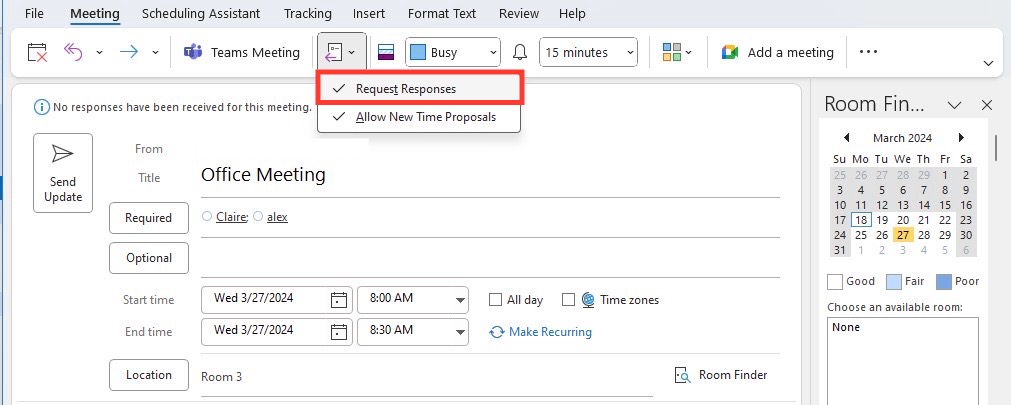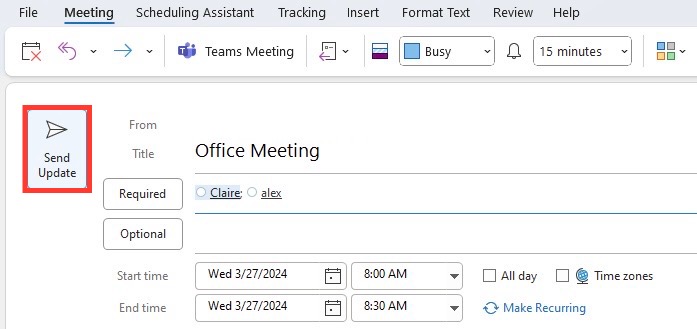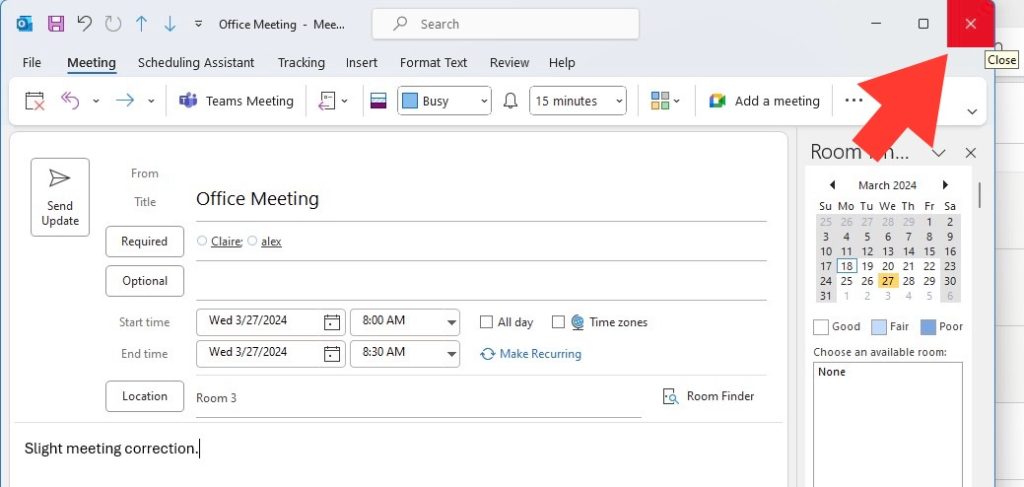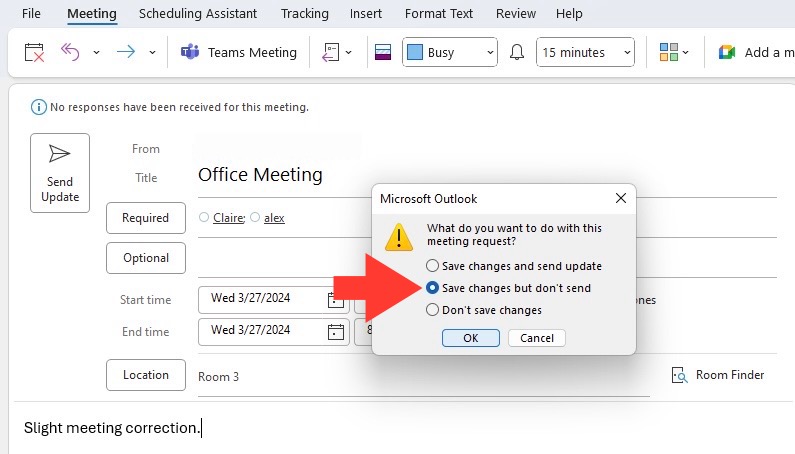When you’re juggling a busy schedule, your Outlook Calendar can be your best friend. It organizes your meetings, appointments, and events, helping you stay on top of your day-to-day affairs. Like a digital assistant, it ensures you’re always exactly where you need to be.
Download our 141 Free Excel Templates and Spreadsheets!
Key Takeaways
- To update Outlook meetings without alerts, utilize the Save feature after making your changes, then click the Save and Close button on the Quick Access Toolbar.
- When changing meeting details that do not include the meeting’s header information, such as time or location, use the Save method to prevent sending out updates.
- To ensure no updates are sent out, you can work offline by clicking the Work Offline button on the Send / Receive tab, then delete the update email from the Outbox folder before reconnecting to the internet.
The Challenge of Silent Updates
Having to update an Outlook meeting can feel like walking through a minefield of potential notification bombs. You might simply want to adjust the meeting time for one invitee or correct a minor typo in the agenda, but the default setting blasts an alert to everyone. They’re then reminded of the meeting and your inbox is cluttered with their acknowledgments. The challenge is clear: how can you make necessary adjustments without triggering an avalanche of emails or alarms? It’s about refining the art of silent updates – making changes without setting off the digital equivalent of sounding the alarm.
Navigating Outlook’s Update Features
Setting Your Preferences for Meeting Updates
Setting preferences for meeting updates is like putting up a sign that says, “Work in Progress, Do Not Disturb.” To make silent tinkering possible, Outlook offers options to tailor your experience. When creating or updating a meeting, you can determine whether attendees should be alerted about the changes.
Here’s how you can adjust those meeting preferences:
STEP 1: Open the meeting in your Outlook Calendar.
STEP 2: Navigate to the Meeting Ribbon.
STEP 3: Look for the ‘Attendees’ group and click ‘Responses’.
STEP 4: If it’s a recurring meeting, remember that the Meeting tab will appear as the ‘Recurring Meeting’ tab.
STEP 5: Within the Responses options, uncheck ‘Request Responses’.
STEP 6: Hit ‘Send Update’ to apply the changes.
Do note that the last step is crucial. Clicking ‘Send Update’ ensures that the meeting request gets updated for everyone without prompting them to send a confirmation response.
Techniques for Managing Meeting Notifications
Managing meeting notifications efficiently could be akin to conducting a symphony; each instrument, or in this case, notification, needs to play at the right time to create harmony in your schedule. Here are some techniques:
- Saving Without Sending: For minor updates that don’t affect the attendees, simply save the changes without sending any notifications. This works best for updates to your personal notes or attachments that don’t need participant action.
- Direct Updates: Modify the meeting details and choose to send updates “only to added or deleted attendees.” This ensures that only those whose participation status has changed get notified.
- Delegation Handling: Empower a delegate with the ability to manage your calendar and handle the nitty-gritty of meeting changes, which can keep your focus on other tasks.
- Template Messages: When an update is substantial, craft a clear, explanatory message that justifies the change and its resend, showing consideration for the attendees’ time.
- Recurring Meeting Strategy: Handle updates to recurring meetings by sending a single update summarizing all future changes, thus reducing the frequency of alerts to your attendees.
Implementing these techniques can aid in striking a balance between keeping everyone informed and reducing the clutter of unnecessary notifications. Each contributes to a less intrusive, more streamlined way of managing your Outlook calendar.
Step-by-Step Guide for Updating Meetings Quietly
Making Changes Without Sending Immediate Alerts
To make changes without alarming your attendees with immediate updates, you’ll need a little finesse and knowledge of Outlook’s more subtle features. Here’s a simple, easy-to-follow method:
STEP 1: Open the meeting invite in your Outlook Calendar.
STEP 2: Make the needed changes, such as updating the agenda or an internal note.
STEP 3: Instead of hitting ‘Send Update’, press ‘Ctrl+S’ to save the changes.
STEP 4: Close the meeting window with the ‘X’ in the corner.
STEP 5: If prompted to send updates, choose ‘Do not Send’.
Voilà! You’ve updated the meeting without firing off an update to everyone. However, this method works best when the changes don’t affect the time, date, or location—details crucial for the attendees.
For location updates that don’t require alerting attendees, consider using the Notes section. This keeps the main location field unchanged, preventing unwanted email notifications.
Please note that these steps can vary slightly depending on your version of Outlook, so it pays to familiarize yourself with the particulars of your software.
Handling Complex Meeting Iterations Discreetly
When dealing with more intricate meeting updates, discretion becomes even more important to maintain the fine balance between staying organized and becoming an inbox nuisance. Here’s a tactful approach to handling complex meeting iterations:
- Private Adjustments: Utilize the ‘Private’ feature for items that are sensitive or irrelevant to other attendees, keeping the general details visible while hiding the specifics.
- Selective Notification: Select the ‘Send updates only to added or deleted attendees’ option when editing your meeting, ensuring only those affected by the change are notified.
- Batch Updates: Instead of sending multiple individual updates, batch significant changes together and send a collective update. This strategy reduces the frequency of alerts your attendees receive.
- Delay Delivery: Use Outlook’s ‘Delay Delivery’ feature to schedule meeting updates to be sent at a later time. This can be strategic in giving yourself a buffer to gather all necessary changes before sending them collectively at a less disruptive time.
- Communicating through Channels: Should the change be something that doesn’t necessitate a formal update, consider using alternative communication channels like a quick email, chat, or even verbal updates if practical.
Handling complex iterations with these methods can help maintain a professional, considerate image while keeping your meeting calendar pristine and current.
Pro Tips for Advanced Outlook Management
Leveraging Rules for Out-of-Sight Updates
To keep your calendar management even further under the radar, leverage Outlook’s rules to manage meeting invites and updates efficiently:
- Automate with Rules: Create custom rules in Outlook for meeting update messages, such as moving them to a dedicated folder. This helps in processing them at your convenience, minimizing distractions.
- Rules for Specific Changes: Set up rules that apply only to meetings with certain keywords or from specific organizers. This helps to filter and sort updates, ensuring you don’t miss crucial information.
- Auto-Responses for Updates: For meetings you’ve organized, configure rules to send out automatic responses to update notifications. This can acknowledge receipt and reassure attendees without requiring manual attention.
With these tips in hand, you can maintain a streamlined updates management process within Outlook, keeping extraneous alerts out of sight and out of mind, thus providing a clutter-free experience.
Avoiding Common Pitfalls When Updating Meetings
Ensuring Accuracy with Minimal Disruption
Accuracy is critical when updating meetings in Outlook, but so is minimizing disruption for attendees. Here’s how to thread that needle:
- Pre-Check Updates: Before making any changes, double-check the details to ensure they’re correct. This prevents the need for further corrections and additional notifications.
- Update Summaries: When sending out necessary alerts, include a clear summary of changes at the beginning of the message. This allows attendees to quickly grasp the updates without sifting through the entire invite.
- Last-Minute Changes: If you must make an urgent update, consider whether it can be communicated through a brief, clear message rather than a meeting update that may cause confusion.
By being meticulous and considerate in your approach to modifying meetings, you can maintain the integrity of your calendar and the sanity of your attendees.
Balancing Transparency with Notification Overload
Successfully managing updates in Outlook requires a deft hand; too much transparency can result in notification fatigue, while too little can sow confusion. Here’s how to strike a balance:
- Critical Updates: Only send out notifications for changes that are essential for attendees to know, such as time or location adjustments.
- Optional Details: For less critical updates, like agenda changes, communicate them at the beginning of the meeting or through informal channels to avoid unnecessary alerts.
- Transparency in Communication: If a notification must be sent, explain why the update was necessary so attendees understand the reason behind the extra email.
Balancing these strategies will keep your attendees informed without bombarding them with notifications, fostering a productive and respectful meeting culture.
FAQ Section
How can I change Outlook meeting details without sending updates to all attendees?
To change meeting details without alerting everyone, open the meeting in Outlook, make your changes, and then save with ‘Ctrl+S’ or the Save icon. If prompted to send updates, select ‘No’ or ‘Do not Send’ to avoid notifying all attendees.
Is there a way to silently add or remove participants from an Outlook meeting?
Yes, you can silently add or remove participants by updating the meeting and selecting ‘Send updates only to added or deleted attendees’. This way, only those whose participation status changed will be notified.
How can I updating the meeting without having new requests sent out?
To update a meeting without sending out new requests, go to the meeting update window, uncheck ‘Request Responses’ under the ‘Responses’ option on the Meeting tab, and then click ‘Send Update’. This adjusts the meeting without prompting attendees to respond.
John Michaloudis is a former accountant and finance analyst at General Electric, a Microsoft MVP since 2020, an Amazon #1 bestselling author of 4 Microsoft Excel books and teacher of Microsoft Excel & Office over at his flagship MyExcelOnline Academy Online Course.











